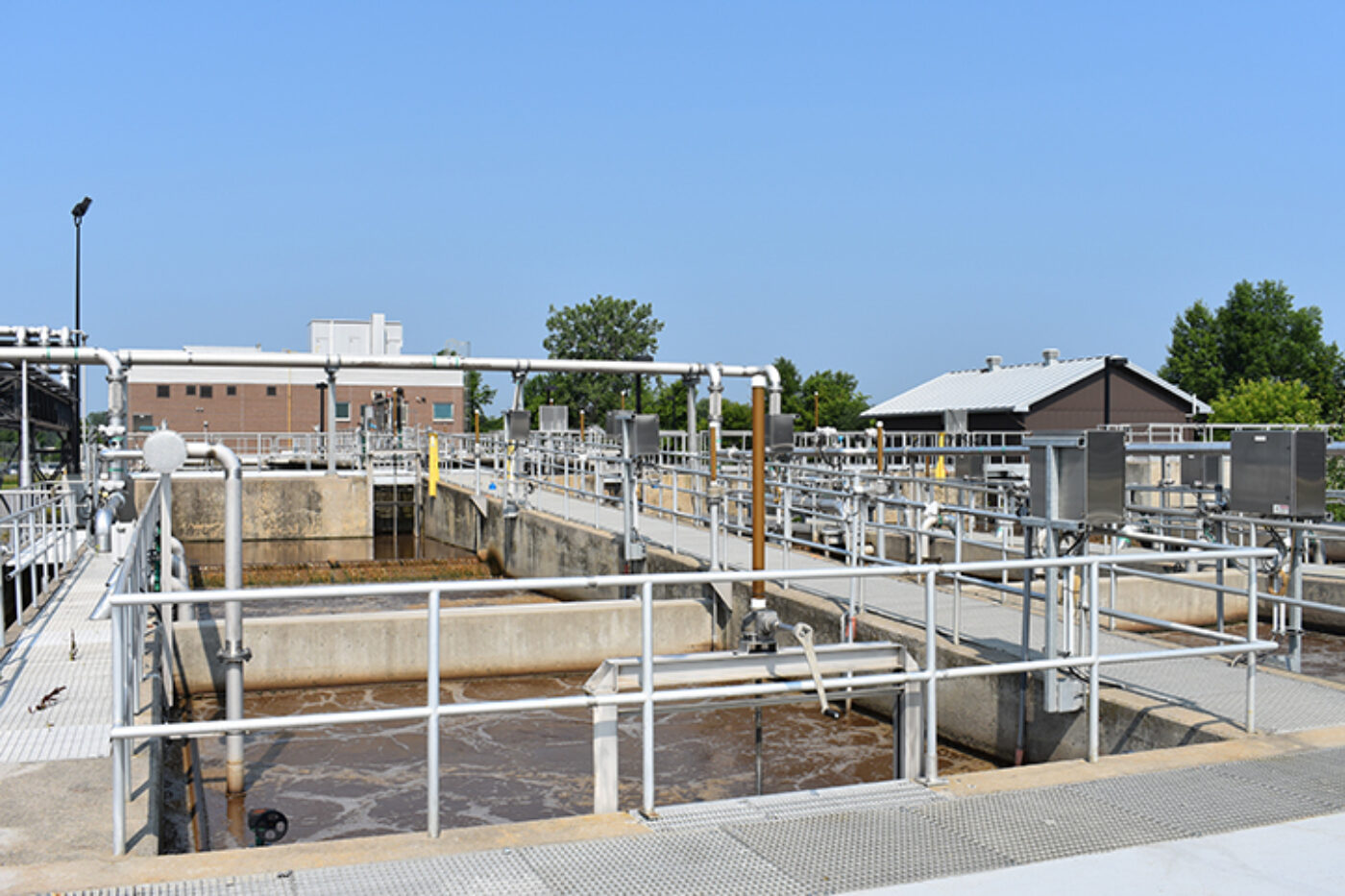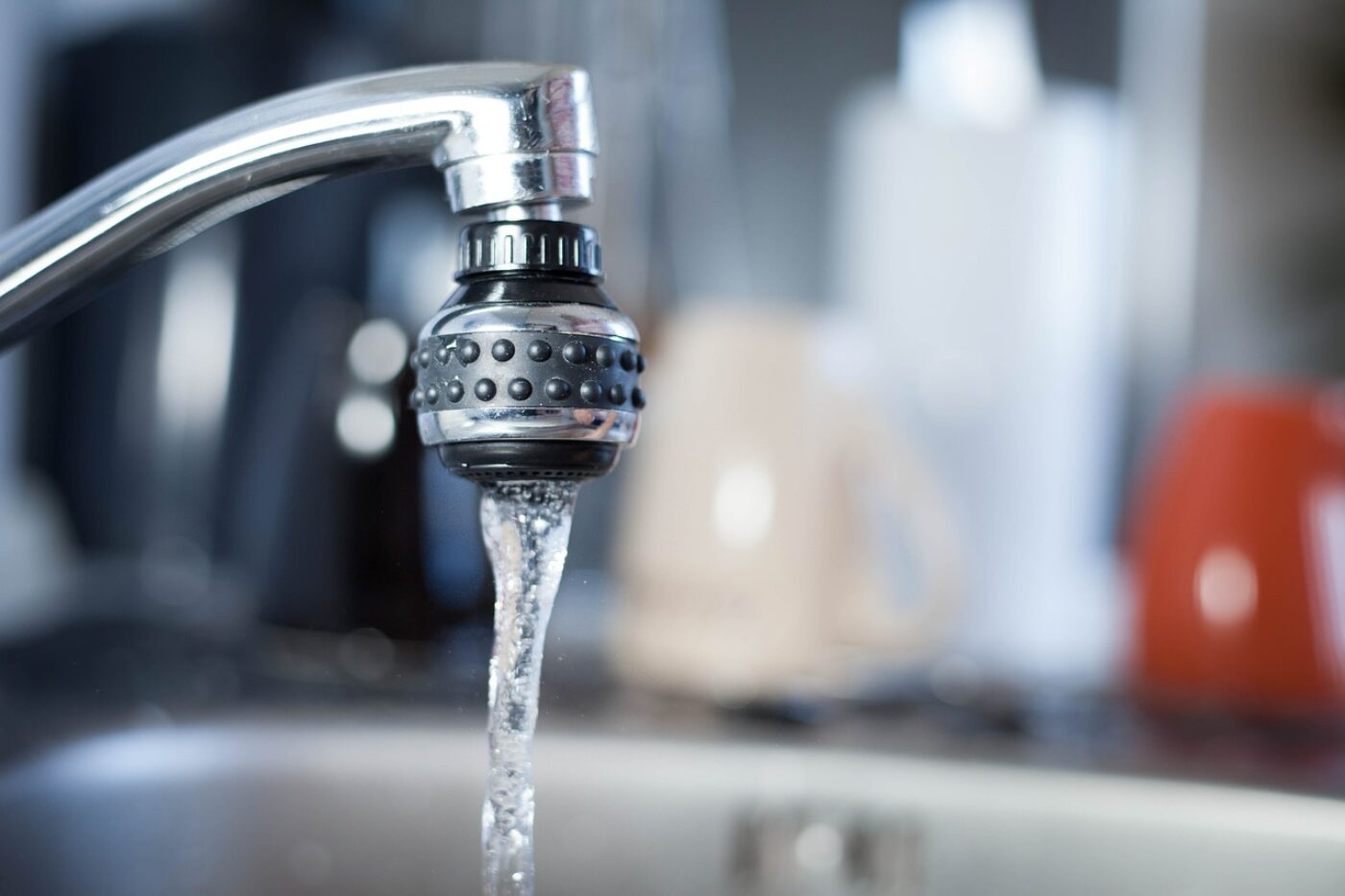Environment (Drinking Water & Wastewater)
Who we are
We are responsible for the operations of the Drinking Water Treatment Plant, the Drinking Water Distribution System and the Wastewater Treatment Plant. Our service operates twenty-four hours a day, seven days a week, by a multidisciplinary certified and licensed team.
Our engagement
We are engaged to:
- Provide safe and clean drinking water to all our citizens and customers,
- Maintain and continually improve our drinking water quality management system,
- Assure the effective treatment of wastewater, and
- Comply with all applicable drinking water and wastewater legislations and regulations.
Annual and summary reports
Drinking water and wastewater annual and summary reports are prepared yearly and report on January 1 to December 31 of the preceding calendar year. Reports are available on-line and at the Hawkesbury Public Library. All efforts are made to ensure the information presented is accurate.
Drinking Water
Drinking Water System
The Hawkesbury drinking water system consists of a raw water pumping station that draws water from the Ottawa River, a drinking water treatment plant, and a drinking water distribution system that includes a remote water storage standpipe with a booster pumping system. Drinking water is distributed to the citizens of the Town of Hawkesbury and to three different sectors in the Township of Champlain.
The water treatment plant consists of a conventional treatment process based on coagulation/flocculation followed by clarification and filtration. The plant is equipped with two dynamic clarifier package units, three high rate sand/anthracite filters, a two-cell clear well with a capacity of 2,300 m³ per cell, and four high lift pumps that supplies treated water into the Town’s distribution system and standpipe.
The Town completed two upgrade phases to the plant between 1996 and 2005. The first phase consisted of an expansion and the installation of the Supervisory Control and Data Acquisition (SCADA) system. The second phase consisted of constructing a storage room for chemical products to house the coagulant.
Did you know?
- That the drinking water treatment plant was built in 1954.
- That it takes about 2 days for the water from the Ottawa River to reach your tap.
- That our water storage standpipe contains approximately 5,450 m³ of drinking water, or the equivalent of a day's production of water.
- That there are over 55 kilometres of underground watermains in Hawkesbury.
- That our water distribution system has more than 350 fire hydrants.
Legislative & Licensing Requirements
The Corporation of the Town of Hawkesbury is the Owner & Operating Authority of the Hawkesbury Drinking Water System. Its system operates in compliance with provincial legislations and regulations as well as under the Ministry’s Municipal Drinking Water Licensing program. On an annual basis, its system is subject to a Ministry of Environment, Conservation and Parks (MECP) comprehensive inspection to ensure it is in compliance with the Safe Drinking Water Act (SDWA) and its regulations.
Furthermore, the SDWA requires Owners and Operating Authorities of municipal residential drinking water systems to have an accredited Operating Authority. To be accredited, an operational plan must be put in place to meet the requirements of the provincial Drinking Water Quality Management Standard (DWQMS).
Accredited by a third-party accreditation body, the Hawkesbury drinking water system and operational plan undergo annual audits to demonstrate its continuous conformity to the DWQMS. You can contact the Town’s Department of Environment if you would like to view a copy of the Hawkesbury Drinking Water System Operational Plan Manual.
The following is a summary description of the legislative & licensing requirements mentioned above. For more information on Ontario's drinking water quality requirements, please visit the MECP's official website.
Safe Drinking Water Act (SDWA)
The SDWA is the principal provincial legislation that regulates the treatment and distribution of drinking water in Ontario. The act and its regulations have several components that have been established to protect drinking water consumers.
Municipal Drinking Water Licensing Program
The Municipal Drinking Water Licensing Program under the SDWA is the approvals framework for municipal residential drinking water systems. To be issued a Municipal Drinking Water Licence (MDWL) by the Ministry, the owner of the drinking water system must have the following:
- A Drinking Water Works Permit (DWWP) which describes the drinking water system components and allows to complete and/or approve certain alterations to the system without requiring additional approval from the Ministry.
- A Permit to Take Water (PTTW) specifying the authorized rates and amounts of source water taking and any potential monitoring or reporting conditions.
- An accepted operational plan which defines and documents the quality management system of the drinking water system in accordance with the requirements of the DWQMS.
- An operating authority accreditation given by a third-party accreditation body recognized by the Ministry.
- A financial plan that outlines the long-term strategy to ensure the financial sustainability of the drinking water system.
Drinking Water Quality Management Standard (DWQMS)
The DWQMS is a set of policies and procedures to ensure the consistent delivery of safe and clean drinking water. It was developed between the MECP and the Ontario water sector following the Walkerton events and Justice O’Connor’s recommendation in the Walkerton Water Inquiry.
Wastewater
Wastewater System
The Hawkesbury wastewater system consists primarily of a sewage collection system and a wastewater treatment plant. The sewage collection system consists of more than 45 km of sanitary sewers, approximately 4.7 km of combined sewers, 1 combined sewer overflow by-pass manhole and 5 sewage lift stations to convey wastewater from lower-lying areas. The wastewater treatment plant has a rated capacity of 13,800 m³/d, a peak flow of 41,000 m³ and, is designated a Class IV Wastewater Treatment Facility. It includes a raw sewage pumping station and several treatment process buildings and reservoirs.
Wastewater leaves all homes and businesses in the town and travels via gravity through the underground sewage collection system towards the raw sewage pumping station, where four pumps deliver the wastewater to the treatment plant.
The wastewater treatment plant uses the activated sludge process, a multi-stage treatment process which consists of 2 screens, 2 vortex grit removals, 3 primary clarifiers, 3 aeration tanks, 4 secondary clarifiers, 128 ultraviolet lamps for disinfection, 2 aerobic digesters, 1 sludge stabilizer and 2 centrifuges.
Once the treatment process is completed, the effluent is discharged into the Ottawa River and the biosolids (dewatered sludge) are disposed of on approved and certified farmland.
Wastewater overflows and bypasses
Wastewater Collection System Background
The Town of Hawkesbury owns, operates and maintains two types of sewer systems; the Stormwater Management System and the Sewage Collection System.
The stormwater system consists of a combination of pipes with curb and channel conveyance along roads which carries stormwater runoff (rainfall and snowmelt) to ditches, catch basins and stormwater management ponds to eventually reach the nearest waterway.
The sewage collection system consists of sanitary sewers and combined sanitary sewers, which are both connected to the wastewater treatment plant.
Sanitary sewers carry only domestic and industrial wastewater, whereas combined sanitary sewers carry both wastewater and stormwater runoff.
Combined sanitary sewers were typically installed before the 1960s in most Canadian cities, where many are still in operation. Some of of the older areas in our Town still have combined sewers, constituting approximately 10% of the sewage collection system. Today, combined sewers are no longer built. In Ontario, combined sewers have not been allowed by the provincial government since 1985.
Combined Sewer Overflow (CSO) and Plant Bypass Events
A CSO event can occur during periods of extreme rainfall or snow melt when combined sanitary sewers overflow with large volumes of stormwater inflows. While most of the stormwater and wastewater flow is carried to the wastewater treatment plant for treatment, the excess volume is discharged into the river.
In the same context, a plant bypass event can also occur during periods of extreme rainfall or snow melt. While the increased volume of stormwater and wastewater can be fully treated for a period of time, if extreme rainfall continues, the volume of stormwater and wastewater reaching the treatment plant may be greater than the limit of what can be treated. In this case, some of the excess sewage flow may need to be diverted around one or more of the plant’s treatment processes before being discharged in the river.
In both cases, CSOs and plant bypasses are a necessary operating condition to prevent flooding and sewer backups in homes and businesses, surface flooding of our roads, and potential damage to the wastewater treatment plant.
Reporting
As required by regulation, all overflow and bypass events are promptly reported to the Ministry of Environment, Conservation and Parks (MPEC), the Federal Ontario Region, the Spills Action Centre and the Eastern Ontario Health Unit (EOHU). These events are also published below on this page.
Recreational Water Quality and Swim Safety
Whether an overflow or bypass event occurred or not, it is recommended that swimming should be avoided for 24 to 48 hours after heavy rains in any watercourse as bacteria levels may be elevated. Before swimming at any public beaches, find out under which Public Local Health Unit it falls and visit their website for current water quality advisories at public beaches.
Drinking Water Quality
Overflow and bypass events do not have an impact on the quality of the Town’s drinking water.
Improvements
While the Town has no control over the volume and timing of an overflow or bypass event, through the Ontario Monitoring and Public Reporting of Sewage Overflows and Bypasses Program, it has made the following improvements:
Monitoring – Installed new water levels, flow monitoring and alarm devices at the wastewater treatment plant and at the combined sewer overflow location. These devices are monitored 24/7 to alert operators if an event occurs.
Reporting – Strengthened current procedures to provide prompt CSO and plant bypass reporting.
Additionally, in the last several years, the Town has been replacing combined sanitary sewers with separate pipe systems for stormwater and wastewater. Among others, the 2019 Cameron Street reconstruction project has greatly lowered the frequency of CSO’s.
Combined Sewer Overflow & Plant Bypass Locations
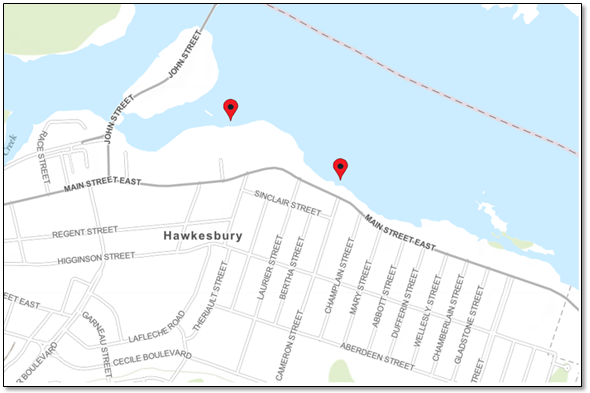
Combined Sewage Overflow & Plant Bypass Events
Events in the following table are posted for public notification. Our goal is to notify the public within 12 hours of an event.
| Date (AAAA/MM/DD) | Event | Cause | Volume (m3) |
|---|---|---|---|
| 2025-07-13 | CSO | Heavy precipitations | 109.82 |
| 2025-05-06 | CSO | Heavy precipitations | 47.52 |
| 2024-09-01 | CSO | Heavy precipitations | 23 |
| 2024-08-18 | CSO | Heavy precipitations | 234 |
| 2024-08-18 | Plant Bypass | Heavy precipitations | 21 368 |
| 2024-08-09 | CSO | Heavy precipitations | 1 518 |
| 2024-08-09 | Plant Bypass | Heavy precipitations | 9 561 |
| 2024-07-24 | CSO | Heavy precipitations | 167 |
| 2024-07-24 | Plant Bypass | Heavy precipitations | 13 403 |
| 2024-07-15 | Plant Bypass | Heavy precipitations | 1 131 |
| 2023-07-28 | Plant Bypass | Heavy precipitations | 947 |
| 2023-07-13 | Plant Bypass | Heavy precipitations | 1 454 |
| 2024-05-01 | Plant Bypass | Heavy precipitations | 1 053 |
| 2022-08-09 | CSO | Heavy precipitations | 28.31 |
| 2022-06-16 | CSO | Heavy precipitations | 41.5 |
| 2022-06-08 | Plant Bypass | Heavy precipitations | 80 |
| 2022-06-07 | CSO | Heavy precipitations | 19.52 |
| 2022-05-15 | CSO | Heavy precipitations | 42.09 |
| 2021-09-15 | Plant Bypass | Heavy precipitations | 14 |
| 2021-09-15 | CSO | Heavy precipitations | 120 |
| 2021-08-13 | Plant Bypass | Heavy precipitations | 928 |
| 2021-06-26 | CSO | Heavy precipitations | 960 |
| 2021-03-26 | Plant Bypass | Heavy precipitations & snowmelt | 6 898 |
| 2021-03-26 | CSO | Heavy precipitations & snowmelt | 1 260 |
| 2020-11-16 | Plant Bypass | Equipment Failure | 2 420 |
| 2020-08-02 | CSO | Heavy precipitations | 44.4 |
| 2020-07-27 | CSO | Heavy precipitations | 34.6 |
| 2020-07-16 | CSO | Heavy precipitations | 438 |
| 2020-03-30 | CSO | Heavy precipitations | 324 |
| 2020-03-29 | CSO | Heavy precipitations | 2 514.7 |
| 2020-03-13 | CSO | Heavy precipitations | 432 |
| 2019-11-01 | CSO | Heavy precipitations | 2 151.4 |
| 2019-10-31 | CSO | Heavy precipitations | 139.1 |
| 2019-10-01 | CSO | Heavy precipitations | 312 |
| 2019-09-23 | CSO | Heavy precipitations | 56.2 |
| 2019-08-09 | CSO | Heavy precipitations | 45.4 |
| 2019-07-20 | CSO | Heavy precipitations | 38.7 |
| 2019-07-11 | CSO | Heavy precipitations | 144.6 |
| 2019-07-11 | CSO | Heavy precipitations | 23.3 |
| 2019-07-05 | CSO | Heavy precipitations | 33.1 |
| 2019-06-25 | CSO | Heavy precipitations | 26.8 |
| 2019-06-02 | CSO | Heavy precipitations | 249.5 |
| 2019-05-23 | CSO | Heavy precipitations | 268.2 |
| 2019-05-20 | CSO | Heavy precipitations | 85.1 |
| 2019-05-10 | CSO | Heavy precipitations | 40.2 |
| 2019-04-20 | CSO | Heavy precipitations | 3 342.8 |
| 2019-04-19 | CSO | Heavy precipitations | 12 |
| 2019-04-15 | CSO | Heavy precipitations | 1 440 |
Protecting Your Plumbing and the Environment
Did you know?
Many items cannot be poured down the sink drain or in the toilet. Why? When they become entangled, they can cause clogging problems in residential sewer lines, the municipal sanitary sewers and the wastewater treatment plant. In addition, toxic products can cause harmful effects on the environment, as they cannot be 100% eliminated through the wastewater treatment process.
To avoid these situations, the following type of products should never be flushed down the toilet or poured down a drain:
- Hygiene products (sanitary, disposable diapers, cotton balls, cotton swabs, dental floss, condoms, bandages, wipes…even those labelled “flushable”)
- Food products (grease, fats, oils, food)
- Household products (paint, pesticides, solvents, nail remover, cleaning products)
- Other (hair, contact lenses, medications, cat litter, paper towels, cigarettes)
Property Line
Responsibilities of a Property Owner and of the Municipality for Maintenance and Repair
What are your maintenance and repair responsibilities as an owner?
- Property owner water service line: The part of the underground pipe that exits your house and goes to the water valve (curb stop) located on your property. Likewise, you are responsible for this underground part of the sewer line.
- Indoor water valve & plumbing: The water pipe system, drains, fittings, valves and accessories in your building that distributes water. Likewise, you are responsible for this part of the sewer lines.
Fire hydrant: The majority of these belong to the Town and may be found at the edge of your property. If this is the case, you are responsible for ensuring that you do not obstruct access to the hydrant (plants, flowers, shrubs, monuments, fences). It is also forbidden to paint the fire hydrants, as they are already painted according to their water flow capacity.
For private fire hydrants which do not belong to the Town, all responsibility rests with the owner.
What are our maintenance and repair responsibilities as a municipality?
- Water Valve (curb stop): The rod with a cast-iron cap nicknamed "curb stop" that is on your property. It is used to turn on and off the water supply between the Town’s drinking water distribution system and your home.
- Municipal water service line: The part of the underground pipe that starts from the water valve (curb stop) and goes to the watermain in the street. Likewise, we are responsible for this underground part of the sewer line.
- Watermain: The 45 km of underground watermain that carries water to the properties supplied by the drinking water distribution network.
- Fire hydrant: Approximately 350 fire hydrants that provide fire protection on the territory of Hawkesbury.
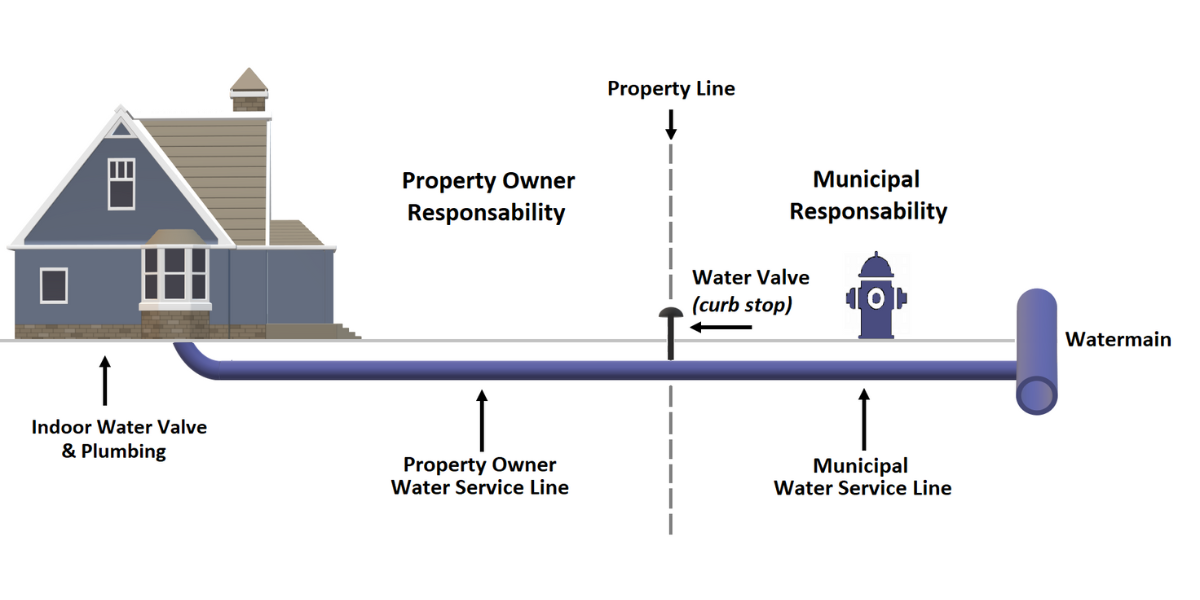
Understanding Your Curb Stop
Did you know?
The water valve, nicknamed the "curb stop", indicates the boundary between your property and that of the Town. It belongs to the Town and should be handled only by municipal employees. It is important that it is functional, visible and accessible so that we can shut off the water supply to your home if you need to do emergency or planned work.
When planning to dig for landscaping, paving or plumbing, contact the Department of Environment 48 hours in advance if you need to:
- Locate your water valve (curb stop) because it is not visible
- Have the water valve (curb stop) lifted, lowered or repaired
- Make a request to close or open the water
Water Meters & Internal Main Shut-Off Valves
What they are and how they work
Your water meter is an instrument that continuously measures and records the volume of water passing through it, therefore your water consumption. It lets you see what you use and how much you pay - just like your electricity bill.
Water meters need water to pass through them in order to record consumption, such as from a tap being turned on or a toilet being flushed. They contain a disk that revolves inside a chamber and as the water passes through that chamber, the disk turns to track your water use in cubic meters. Water meters are mechanical devices and have no electrical components inside them. They either record consumption accurately or start under-registering with age.
The following video also explains it very well: Water meter mechanism
As for your internal main water shut-off valve, its purpose is to allow you to shut off the water in your building for several reasons, including emergencies; repairing leaks, taps or toilets; and when leaving home for an extended period of time.
There are 2 common types of main water shut-off valves – the gate valve and the ball valve. Older buildings will often have a gate valve. This type of valve features a circular “wheel” handle, which is turned to open or close the water. Newer buildings will most likely have a ball valve. This type of valve features a lever handle that has 2 positions – On and Off. Today, the ball valve is frequently recommended as it is more effective at forming a tight seal and has more reliability and longevity than the gate valve.
Very important! What to do before digging
Call before you dig
Are you planning on doing any of the following activities?
- Building a terrace or porch
- Installing a fence
- Paving your driveway
- Planting or felling a tree
- Laying out a new garden or landscaping
- Installing a pool or spa
This is a reminder that is not the municipality's responsibility, it is essential that you contact Ontario One Call.
You are responsible for :
- Calling 1-800-400-2255 or visiting ontarioonecall.ca at least 5 days before you start digging to request the location of underground infrastructures, no matter how big or small the project.
- If you're hiring a contractor, make sure they've contacted Ontario One Call before starting the work.
Asking for locations before digging not only protects you and others from the risks associated with underground infrastructures, it's also a legal obligation.
If you have any questions, contact Ontario One Call. This service is free and available 24 hours a day, 7 days a week.
Note: A locate request does not replace the need for a building permit. Before undertaking any work on your property, regardless of its nature or scope, contact the Town's Construction Department at infoconstruction@hawkesbury.ca to check if a permit is necessary.
Location and Responsibilities
Here’s a very important question for every property owner. Do you know where the water meter and internal main water shut-off valve are located in your building? We are not expecting everyone to be experts in plumbing, but by knowing where these are located, it can help minimize and prevent problems.
Your water meter is generally located in your basement, along the front wall and near the floor, after your main water shut-off valve. If you don't have a basement, look for it in a crawlspace or on the main floor.
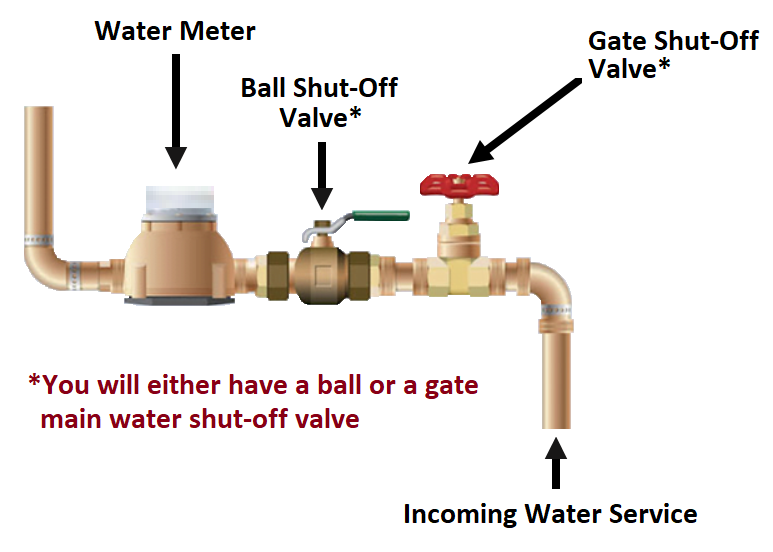
Water meters are the property of the Town. However, you are responsible for taking care of it and all your indoor plumbing, including pipes and water shut-off valves.
Always maintain clear access to the meter and provide adequate heating to prevent damage during freezing winter temperatures. Likewise, your internal main water shut-off valve should always be accessible and ready for use in case of an emergency.
If your water meter is damaged or frozen because you didn’t take proper care of it, you will have to pay for the meter replacement.
Water Meter Reading and Billing
The Town reads your water meter on a monthly basis, through battery electronic radio transmitter technology. This technology uses a mechanism that is connected directly to your water meter, where it transmits data from your meter to a handheld device used by a Town employee as they drive by your residence.
As all meters have a unique identification number, this device will match your meter’s identification number and will record its reading only. At the end of the day, the handheld device transfers the information into our billing system.
High Water Bill
If you see a sudden rise in your bill and you have not changed your water usage, this is a sign that you have a leak in your plumbing system. A sudden increase in the amount of your bill could be due to several reasons:
- Plumbing leaks in toilets, taps, pipes, garden hoses
- An increase in the number of people living or working in your residence
- A hot and dry summer, resulting in higher water consumption
- Renovations, recent landscaping or filling of a swimming pool
Before contacting the Town, check if you have a leak. Here are few easy ways that can help you confirm the presence of one, without needing the assistance of a plumber:
- Toilet check: Because the most common reason for a leak is toilets, this is the first thing you want to check. Simply add food colouring in the tank and let it sit for about 20 minutes. If the colour shows up in your toilet bowl, this means you have a toilet that leaks. You can also look inside the tank. If the water is flowing into the overflow tube once the tank is full, you have a leak.
- Leaky Faucet or hose - Unlike a leaky toilet, a leaky faucet is easy to notice because of the sound of dripping water. Take a walk through your home and backyard to check for leaking faucets.
- Water meter check: Turn off all water faucets in your home (but not your main water shut-off valve) and make sure no appliances are using water, such as washing machines and dishwashers. Locate your water meter and write down the numbers you see. Wait an hour, preferably longer if you can, and check the numbers again. If the numbers have changed, there’s a leak somewhere.
Who to Contact
If the water meter is leaking, please contact the Town as soon as reasonability possible to prevent property damage and water loss.
The Town is not responsible for leaks in your internal pipes or your main water shut-off valve. Contact a plumber if one of these is leaking.
For questions related to bills, please contact the Finance Department by e-mail at Infotaxes@hawkesbury.ca.
For questions related to the purchasing and acquisition of water meters, please contact the Construction Department by e-mail at infoconstruction@hawkesbury.ca.
Contact the Department of Environment 48 hours in advance at 613 678-9269 or by email at infowater@hawkesbury.ca if you need to:
- Locate your water valve (curb stop) because it is not visible, or have it lifted, lowered or repaired
- Make a request to close or open the water
Outside office hours, if the problem is urgent, please contact us at 613 632-1105
Prevent Water Waste: Tips to Detect and Avoid Costly Leaks
Did you know?
A water meter is a water conservation tool! It not only measures and record the volume of water consumed, it helps detect leaks in homes and businesses.
A continuous water leak can waste the following amounts:
| Leak diameter | Quantity of water wasted | Costs* (according to the water and sewer fee for the current year) | ||
|---|---|---|---|---|
| Metric | Imperial | Metric | Imperial | $2.63 |
| 6,4 mm | 1/4" | 50 m3 (50,000 liters) / day | 13,200 gallons / day | $132 / day |
| 4,8 mm | 3/16" | 28 m3 (28,000 liters) / day | 7,392 gallons / day | $74 / day |
| 3,2 mm | 1/8" | 12 m3 (12,000 liters) / day | 3,168 gallons / day | $32 / day |
| 1,6 mm | 1/16" | 3 m3 (3,000 liters) / day | 792 gallons / day | $8 / day |
To prevent these sudden hikes, check for leaks at least once a year. You should also close your internal main water shutoff valve when you go on vacation or are away from your property for a long time. This can limit the possible water damage if a pipe breaks or if your house loses heat (e.g. power outage) and the pipes freeze.

Service Line Warranty Program
Have More Questions?
For questions related to the quality of drinking water, water leaks, water interruptions, bulk water sale, water turn-on and turn-off requests:
E-mail: infowater@hawkesbury.ca
Phone: 613 678-9269
For an emergency outside office hours, contact the Fire Service Dispatch Center at 613-632-1105
You can also visit our FAQ page for answers to common questions!
